 |
Focus features two in-depth reviews each month of fine art, architecture, and design exhibitions at art museums, galleries, and alternative spaces around Japan. |
|
|
 |
 |
 |
The Beauty of Ainu Handiwork at the Japan Folk Crafts Museum
Susan Rogers Chikuba |
 |
The main building of the Japan Folk Crafts Museum, designed by founder Soetsu Yanagi, is a registered Cultural Property. With the pleasing creak of its solid wood floors, soft lighting, vintage showcases, and the honest integrity of the works on display, it is always an oasis of serenity. Photographs by Susan Rogers Chikuba
|
Twenty-four river stones click and clack softly as they dangle from the warp threads of the rush mat Etsuko Hori is weaving in Hirakawa, Hokkaido. "I love that sound," she says of her loom weights. Around her sit piles of dried cattail blades, linden-bark fibers (some she has dyed black and red), and fine linden twine that she has twisted herself -- she'll use 100 meters of it to make a single 1.4-meter mat. As she works, even stray cattail fibers do not go to waste; she sets them aside to make string later. Hori's creative process, and that of other present-day Ainu artisans featured in the "Hands and Hearts" video series produced by the Foundation for Ainu Culture, offers welcome context to the late-18th and 19th-century heritage works on display in The Beauty of Ainu Handiwork, an exhibition now showing at the Japan Folk Crafts Museum (Nihon Mingeikan) in Tokyo through 23 November.
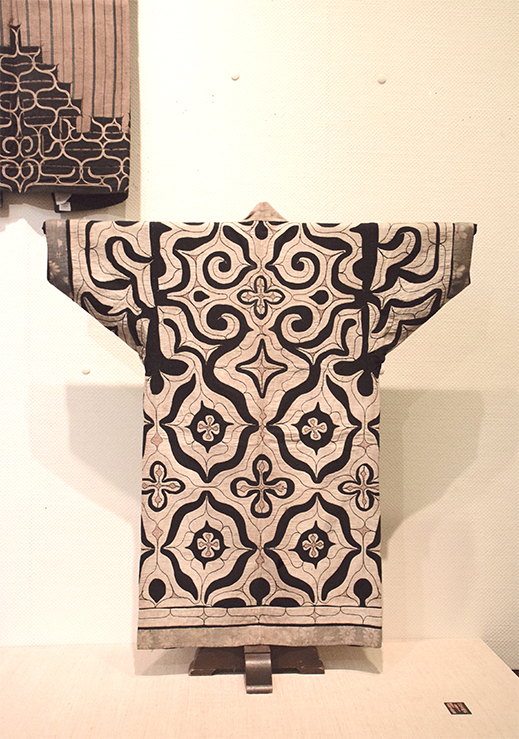 |
|
 |
|
|
|
Chain and closed-feather stitching add soft accents of pink to this big bold design of embroidered appliqués. With the advent of machine looms, larger pieces of cloth came to be used in such patterning. Photographs by Susan Rogers Chikuba
|
Drawn from the collections of Mingeikan founder Soetsu Yanagi (1889-1961) and textile designer, Mingei advocate, and Living National Treasure Keisuke Serizawa (1895-1984), the show is a scaled-down version of one by the same title that opened, to much acclaim, in Sapporo last November and concluded in Miyagi in March. At this Tokyo iteration, thanks to the intimate setting of Mingeikan, it's possible to get right up close to the many garments on display, the better to appreciate each carefully worked stitch. Robes fashioned of cotton and tree bark are shown along with colorful tamasai beaded necklaces, ikupasuy libation sticks, lacquered cups and vessels, lavishly woven sword straps, and other once-treasured family items. Yanagi wrote of his vision for Mingeikan, which opened in 1936, that a visit should "convince any open mind of the great beauty that the simple and ordinary men and women of the countrysides of Japan put into the work of their hands." An exhibition curated here in 1941 by Serizawa was the first to celebrate Ainu handicraft as art, a concept that underpins this show, too, eight decades on.
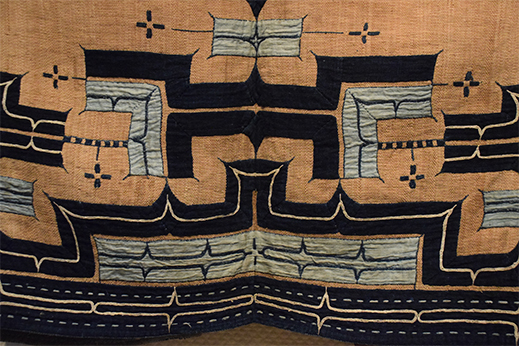 |
|
Hem detail of an attus elm-fiber garment with embroidered appliqués. Yanagi wrote that he valued Ainu figurative art not only for its beauty, but also for its "fine, even mysterious, sense of the ingenious power of creation." Photograph by Susan Rogers Chikuba
|
Traditional Ainu-made garments were woven from the inner bark of elm and linden trees, nettle fibers, salmon and trout skins, deer, seal, and bear pelts, and even tufted puffin feathers. Later, cotton or silk obtained through trade was cut into appliqués that were stitched on and further embellished with embroidery. The patterns differ by region. "Today we take it for granted that we can begin with a bolt of cloth," says sewing instructor Ikuko Okada, who heads a community group in Shiraoi, Hokkaido that's dedicated to reviving skills that were a matter of course just two or three generations ago. "But when you look closely at vintage cotton robes, you see how even the smallest bit of fabric was put to good use." Okada immersed herself in old photos to learn the appliqué patterns that were unique to her locale. "We study the old ways, learn from them, and then carry on that tradition by adding our own creative expressions and arrangements. This is how you keep your roots alive."
|
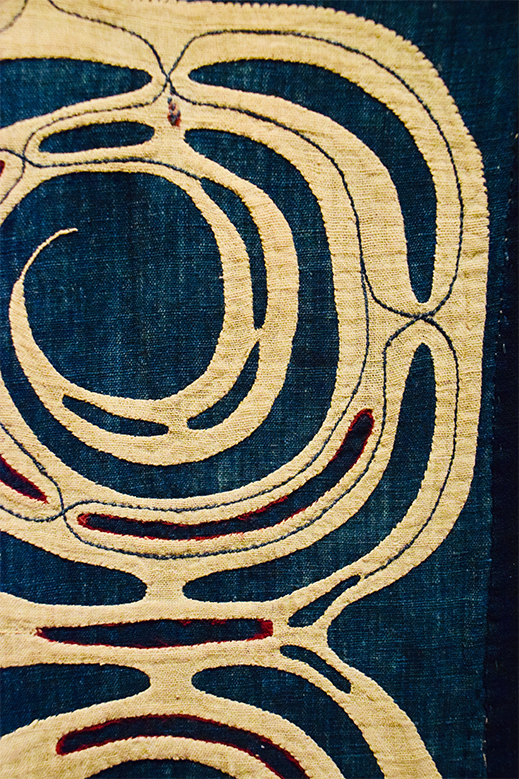 |
|
|
|
Detail of a cotton garment decorated with embroidered appliqués. Wrap-around couching stitches, called ikarari in Ainu, enliven the design. Photograph by Susan Rogers Chikuba
|
Ainu patterns are at first glance symmetrical, but upon close observation even seeming mirror images reveal playful divergences that nonetheless support a unified geometric whole. (I think this dovetails nicely with the worldview of Ainu and other northern peoples, but will save that exploration for another day.) Two basic components to look for, whether rendered by needle on cloth or by a carver's knife on wood and bone, are bracket-like ayus and the gently curving whorls and spirals called morew. These are flipped horizontally or vertically to create repetitive patterns and Escher-like positive and negative grounds. Some believe they protect the owner from evil spirits, which is why on clothing these motifs are typically placed on the back and near openings such as at the wrists, neck and lower hem. Another characteristic element is the kiraw, a thorn-like extension of the pattern that juts into the opposing ground, also said to be a talisman for protection.
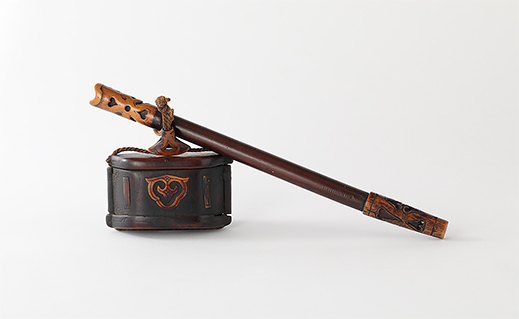 |
|
Tobacco box and pipe holder, Shizuoka City Serizawa Keisuke Art Museum. Shigeru Kayano recounts in Our Land Was a Forest that an Ainu man would fill his pipe with tobacco and offer it, as a friendly gesture, to someone he had met for the first time. Reciprocated, the exchange was an opportunity for the two to examine and comment on each other's carving skills and style. |
As pipes and makiri knife hafts and sheaths count among the most personalized items one could own, it's fun to imagine the characters of those who carved the vintage ones on display. In his Hidaka home today, Tahachi Urakawa makes his own makiri for hunting and fishing. He, too, pored over archival materials to study how it was done. He says he taught himself how to carve in the basement storeroom of the Hokkaido Historical Museum, and learned tips on reading wood grain and sharpening a blade from carvers who worked at a company supplying the tourist trade, where he part-timed as a driver. Urakawa uses the light, strong wood of the painted maple tree to fashion two halves of a sheath, which he then binds with nikawa glue he extracts from deer hooves. He inlays bands of cherry bark, both to decorate the sheath and to protect its seams against moisture, then finishes the whole with decorative carvings of his own free-spirited design. He uses pine resin to fix the tang of his new blade in its haft, and ultra-fine deer sinew to secure the knots of the set's braided cords.
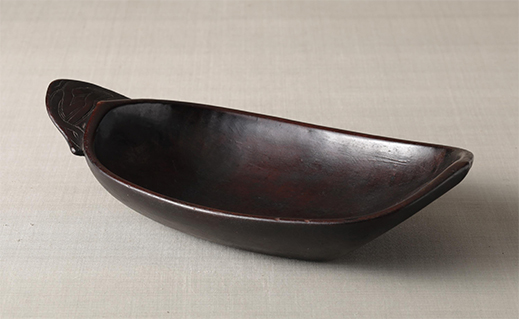 |
|
Housewares like this Sakhalin Ainu wooden tray were often carved simply, in contrast to the intricate designs rendered on personal effects. |
True to Yanagi's wish that we encounter a work on its own merits and with "the eyes of intuition," captions at Mingeikan are famously minimal. Still, the short documentary films that play on the second floor, featuring contemporary artisans who work in the same traditions as those unknown hands of yesteryear, do bring added depth to one's experience of the exhibits. Each is about 20 minutes long and they are available online with English subtitles -- see the list at the end of this review to watch before you go. Knowing only a little about woodcraft and weaving, and next to nothing about mat-making or needlework, I was glad for this resource, and find its tacit subtext -- how some present-day Ainu people seek to re-kin themselves through their study of ancestral material -- poignant to say the least. If you read Japanese, the August and September issues of Mingei magazine are dedicated to Ainu arts, with essays by artists, designers, and scholars.
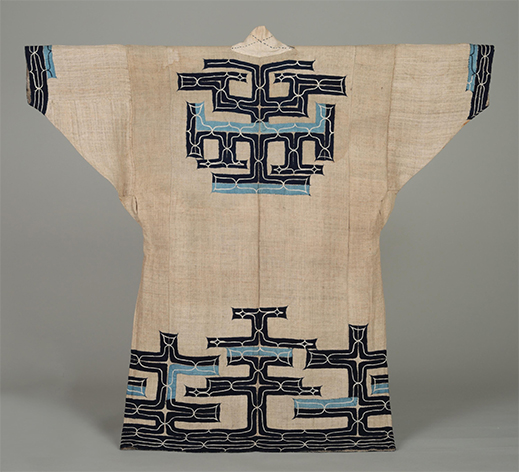 |
|
Embroidered and appliquéd robe of woven nettle fiber. Soft, breathable, and especially time-consuming to make, light-colored nettle cloth was highly valued among the Sakhalin Ainu. |
Select segments from the "Hands and Hearts" craft documentary series by the Foundation for Ainu Culture:
Detail of a ceremonial rush mat. In olden times cattail blades would be harvested in the fall, with the snowbound winter months given over to the time-consuming tasks of making tree-fiber twine and the actual weaving. Photograph by Susan Rogers Chikuba |
All photo permissions are courtesy of The Japan Folk Crafts Museum. |
 |
 |
Susan Rogers Chikuba
A Tokyo-based writer, editor and translator, Susan Rogers Chikuba has been following popular culture, design and art in Japan for three decades. She has edited works from bestseller crime mysteries to a film series on the country's Living National Treasures. In addition to developing communication tools for the hospitality and travel industries she covers little-known destinations and the people and lifestyles found there for domestic and international publications. |
|
 |
|